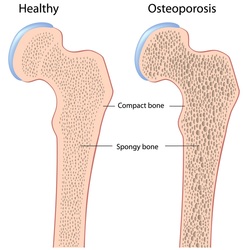Osteoporosis

Osteoporosis is a condition in which a decrease in the density of bones weakens the bones, making fractures likely. Bones contain minerals, including calcium and phosphorus, which make them hard and dense. To maintain bone density, the body requires an adequate supply of calcium and other minerals and must produce the proper amounts of several hormones, such as parathyroid hormone, growth hormone, calcitonin, estrogen, progesterone and testosterone. An adequate supply of vitamin D is also needed to absorb calcium from food and incorporate it into bones. Vitamin D is absorbed from the diet and also manufactured in the skin using sunlight.
Loss of Bone Density in Women
In women, bone density (or mass) progressively increases until about age 30, when bones are at their strongest. After that, bone density gradually decreases. The rate of bone loss accelerates after menopause, which occurs on average around age 51. A major cause of osteoporosis is a lack of estrogen, particularly the rapid decrease that occurs at menopause. Most men over 50 have higher estrogen levels than postmenopausal women, but these levels also decline with aging, and low estrogen levels are associated with osteoporosis in both men and women. Estrogen deficiency increases bone breakdown and results in rapid bone loss. In men, low levels of male sex hormones also contribute to osteoporosis. Bone loss is even greater if calcium intake or vitamin D levels are low. Low vitamin D levels result in calcium deficiency and increased activity of the parathyroid glands (secreting parathyroid hormone), which can also stimulate bone breakdown.
Risk Factors for Osteoporosis
At first, osteoporosis causes no symptoms because bone density loss occurs very gradually. Some people never develop symptoms. Eventually, however, bone density may decrease enough for bones to collapse or fracture, causing severe sudden pain or gradually developing aching bone pain and deformities. In long bones, such as the bones of the arms and legs, the fracture usually occurs at the ends of the bones rather than in the middle. The bones of the spinal column (vertebrae) are particularly at risk of fracture due to osteoporosis. The fracture usually occurs in the middle to lower back.
If you have any of the symptoms above, please contact Dr. Linda Gedeon for proper evaluation and to discuss the best treatment options for you.
Loss of Bone Density in Women
In women, bone density (or mass) progressively increases until about age 30, when bones are at their strongest. After that, bone density gradually decreases. The rate of bone loss accelerates after menopause, which occurs on average around age 51. A major cause of osteoporosis is a lack of estrogen, particularly the rapid decrease that occurs at menopause. Most men over 50 have higher estrogen levels than postmenopausal women, but these levels also decline with aging, and low estrogen levels are associated with osteoporosis in both men and women. Estrogen deficiency increases bone breakdown and results in rapid bone loss. In men, low levels of male sex hormones also contribute to osteoporosis. Bone loss is even greater if calcium intake or vitamin D levels are low. Low vitamin D levels result in calcium deficiency and increased activity of the parathyroid glands (secreting parathyroid hormone), which can also stimulate bone breakdown.
Risk Factors for Osteoporosis
- Family members with osteoporosis
- A diet that is low in calcium and vitamin D
- Sedentary lifestyle
- Thin build
- Early menopause
- Cigarette smoking
- Excessive alcohol or caffeine consumption
At first, osteoporosis causes no symptoms because bone density loss occurs very gradually. Some people never develop symptoms. Eventually, however, bone density may decrease enough for bones to collapse or fracture, causing severe sudden pain or gradually developing aching bone pain and deformities. In long bones, such as the bones of the arms and legs, the fracture usually occurs at the ends of the bones rather than in the middle. The bones of the spinal column (vertebrae) are particularly at risk of fracture due to osteoporosis. The fracture usually occurs in the middle to lower back.
If you have any of the symptoms above, please contact Dr. Linda Gedeon for proper evaluation and to discuss the best treatment options for you.

